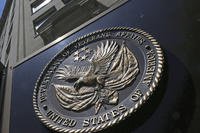
Defense Tech friend and Strategy Page contributor Harold Hutchison sent this quick piece over to us on the Joint Strike Fighter. Ill post it here as food for thought, and we look forward to Harolds next post on aviation and other defense-related subjects.
My two cents on the issue is that I tend to agree with his thesis that the JSF is a good buy given its performance and stealth. What he does not address, however, is the likelihood the cost will climb even further if the programs buy is reduced. Then the cost/performance ratio wont be as compelling as Harolds analysis today.
There's rumbling in both Congress and the Pentagon that the STOVL version may get dumped, the Navy won't buy in the numbers they'd previously thought, the Brits may bail...all these events are possible and could throw the value argument out the window. We'll see. But on the face of it, Harold's got a pretty good point. Read on...
Is the F-35 overhyped? That is one question that is being asked in light of both American refusal to release the source code for software, as well as the climbing price (up to $63 million per-plane). The real answer depends on what competing aircraft have to offer.
How does the F-35 compare in the air-to-air mission against likely competitors like the French Rafale, the Swedish Gripen, and the multi-national Eurofighter? All of European planes boast some of the best electronics suites that have ever provided for a combat aircraft. All are capable of high speed (over 2,000 kilometers an hour). All three aircraft carry excellent beyond-visual-range missiles (like the Mica, AMRAAM, and Meteor). All are highly maneuverable. But will they be better than the F-35 in a fight?
The answer, surprisingly, is probably not. The F-35 has one big advantage over these three fighters from Europe. Its radar signature, its vulnerability to being picked up on radar, is very low as is the case with the F-117 and F-22. Given that its speed is pretty comparable to the European jets, and its AESA radar is at least as good as the European systems, this is a decisive advantage. The best weapons in the world are useless if they cannot see their targets.
The F-35 will be able to see the Rafale, Gripen, and Eurofighter long before it can be seen itself. The first rule of air combat may be "speed is life", but the second rule is "lose the sight, lose the fight". In the 21st century, sight includes radar. It is very likely that the only warning the F-35 may give of its presence will be when its radar has locked on to one of the European fighters. By that point, the F-35 is already close to launching its AMRAAMs.
The cost differential is not as big as one might think, either. The F-35 runs at $63 million (for the most expensive variant), but the Gripen is $50 million per plane, the Rafale runs about $65 million each, and the Typhoon is $58 million. That is not much difference in terms of cost.
In essence, the F-35's small additional cost gains a huge edge in a fight.
Ultimately, the F-35 does cost a little more than most of its European competition. That said, in a fight, an F-35 is probably a little better than the competition, largely due to its stealth technology. Even then, there will be far more F-35s than the combined total of the planned production runs of the Rafale, Typhoon, and Gripen. In essence, the F-35 is going to have a qualitative edge, and the quantitative edge.
-- Christian








